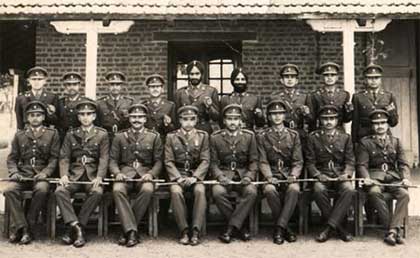The Grenadiers
Indian Grenadiers
 The Grenadiers have one of the longest and unbroken records of existence in the Indian Army. Grenadier companies of Bombay Sepoys were part of the British
India Army and won the battle of Talegaon against the Marathas in 1778. By 1784 the Grenadier companies had been given the title of Bombay Grenadiers and later became
the 1st Grenadier regiment in 1796. In 1903 they were renumbered as the 101st Grenadiers and went on to serve on several fronts during both World War I and World
War II. In 1945 the regiment was redesignated The Indian Grenadiers and assigned to India as the country was partitioned by the departing British.
The Grenadiers have one of the longest and unbroken records of existence in the Indian Army. Grenadier companies of Bombay Sepoys were part of the British
India Army and won the battle of Talegaon against the Marathas in 1778. By 1784 the Grenadier companies had been given the title of Bombay Grenadiers and later became
the 1st Grenadier regiment in 1796. In 1903 they were renumbered as the 101st Grenadiers and went on to serve on several fronts during both World War I and World
War II. In 1945 the regiment was redesignated The Indian Grenadiers and assigned to India as the country was partitioned by the departing British.
The 1st Grenadiers were transferred to the Brigade of Guards in 1950 and a parachute regiment was raised in 1952. Today the Indian Army sports 19 regular battallions of Grenadier troops. The regiment has seen combat service with the Indian Army, including the wars against Pakistan in 1965 and 1971. The Grenadiers played an important role in the Kargil War of 1999 against Pakistani military personnel that occupied Indian territory. Their gallantry was displayed during the battles of Tololing, Point 4590, the Three Pimples and most significantly in their historic re-capture of Tiger Hill on the night of July 3-4, 1999. After Kargil, the Grenadiers were part of the Indian military contingent deployed after the heinous attacks carried out by Pakistani Islamist terrorists on November 26, 2008 in Mumbai.
Over its history in post-independence India, the Grenadiers have earned three Param Vir Chakras which are the highest gallantry award of the Indian Army. They have also won two Ashok Chakras, seven Maha Vir Chakras, four Kirti Chakras, two Param Vishisht Seva Medals, two Ati Vishisht Seva Medals, two Uttam Yudh Seva Medals, thirty three Vir Chakras, sixteen Shaurya Chakras, three Yudh Seva Medals, seventy one Sena Medals and twenty seven Vishisht Seva Medals. Their regimental motto and battle cry is "Sarvada Shaktishali" (Ever Powerful).
Current battalions of the Indian Grenadiers
2nd Battalion (102nd KEO Grenadiers)3rd Battalion (108th Infantry)
4th Battalion (109th Infantry)
5th Battalion (112th Infantry)
6th Battalion
8th Battalion
9th Battalion (ex-State Forces unit)
11th Battalion (ex-Territorial battalion)
12th Battalion
13th Battalion
14th Battalion
15th Battalion
16th Battalion
17th Battalion
18th Battalion
19th Battalion
20th Battalion
21st Battalion
22nd Battalion

Officers of the 14th Grenadiers at their raising ceremony on January 1, 1965 in Nasirabad, Rajasthan, India.
Documentarty about the Indian Grenadiers by the Indian TV station Bharat Tak (in Hindi).